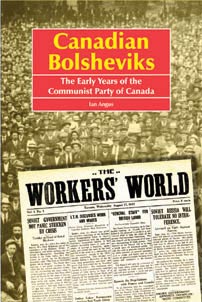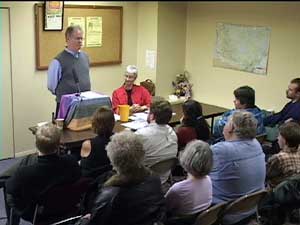Announcing the Second Edition of
Canadian Bolsheviks
The Early Years of the
Communist Party of Canada
By Ian Angus
The Socialist History Project is very pleased to announced that
Canadian Bolsheviks: The Early Years of the Communist Party of Canada, by Ian Angus,
has been republished in cooperation with Trafford Publishing. Canadian
Bolsheviks describes and
explains the first attempt to build a Leninist Party on Canadian soil,
showing why it succeeded so well at first, and why it ultimately
failed. This path-breaking work, originally published in 1981, has been out of
print for some time.
 The photo at the right shows the Nov. 17, 2004 Vancouver meeting for
Canadian Bolsheviks. All the presentations at that meeting can be viewed
on line at
WorkingTV.com. The photo at the right shows the Nov. 17, 2004 Vancouver meeting for
Canadian Bolsheviks. All the presentations at that meeting can be viewed
on line at
WorkingTV.com.
Socialist Voice published a report
on the public meetings that were held in Vancouver and
Toronto in November 2004, to celebrate the new edition of Canadian
Bolsheviks.
If you are interested in organizing
(or helping to organize) a meeting to discuss and promote Canadian
Bolsheviks, email Ian Angus at
ian@socialisthistory.ca
Reviews, positive and negative
How to Order Canadian Bolsheviks
Suggested Retail Price
Can$31.95 • US$25.60 • EUR20.80 • £14.41
To order Canadian Bolsheviks online
Amazon USA:
Amazon.com
Amazon UK and EU:
Amazon.co.uk
Chapters Canada:
Chapters.Indigo.ca
Order Direct from the Publisher
Online:
Trafford Publishing
Phone:
Canada & U.S: 1-888-232-4444
UK & EU: +44 (1270) 252-889
Trade Orders: Canada & US
Phone 1-888-232-4444
Fax 1-250-383-6804
Email orders@trafford.com
Trade Orders: UK & EU
Phone +44 (1270) 252-889
Fax +44 (1270) 251-609
Email andy.smith@trafford.com
Publication Info
Published by The Socialist History
Project in association with Trafford Publishing
ISBN 1-4120-3808
Trafford catalogue #04-1623
Trade paperback (6x9), perfect bound, 339 pages
Preface to the Second Edition, 2004
Twenty-five years ago, I wrote Canadian Bolsheviks
to rescue the history and achievements of the first generation of
Canadian revolutionary socialists from decades of distortion by both
anti-communist and Stalinist writers.
The book was well received in academic circles and
(more important to me) by people who looked to the first attempt to
build a revolutionary party in Canada for lessons and inspiration in
their own efforts to change the world.
Recent years have seen a new rise of interest in
radical ideas and movements. Hundreds of thousands of young people
around the world are looking for paths to social change. Most aren’t
Marxists, of course—more often than not, they accept the
Marxism=Stalinism=Totalitarianism
equation that our society’s opinion-shapers promote.
But for anyone who wants to go beyond
criticizing the world as it is, to
actually changing it, the
experience of the revolutionaries who founded and built the Communist
Party of Canada is directly relevant.
The men and women who built the Communist Party of
Canada weren’t perfect. They made mistakes. They weren’t even aware of
some of the issues we consider important today. But they committed their
lives to social change, and did the best they could—and they built the
most successful, principled, and effective revolutionary organization
Canada has ever seen. They have a lot to teach us.
I offer the second edition of
Canadian Bolsheviks
to the new generation of Canadian
radicals, as a contribution to your debates and discussions on how to
change the world.
* * *
Two or three years ago, after many years in which
other responsibilities kept me from writing about revolutionary history,
I began receiving e-mails and phone calls asking about
Canadian Bolsheviks.
Some of the queries came from academics, some from socialist groups, and
a gratifying number came from individuals who wanted to discover the
history that was omitted from their school books.
Most wanted to know where to find the book: sadly,
I had to tell them that
Canadian Bolsheviks was out
of print. Now I no longer have to say that.
When I decided to arrange a second edition, I
considered doing a complete revision based on research that has been
done over the past 25 years. But while that research has added a great
deal to my understanding of the developments discussed in
Canadian Bolsheviks,
it hasn’t changed the overall picture, and a complete rewrite would have
substantially delayed getting Canadian Bolsheviks back into
print. So this edition is substantially the same as the first.
In addition to spelling corrections*
and minor stylistic changes, the changes I have made fall into four
groups:
- I have taken advantage of new
technology to include some pictures and to correct and expand the
Index.
- In a few cases, I have changed the
present tense to the past tense in passages referring to events in the
1980s, or to individuals who were alive in 1981 but have since died.
Similarly, I have noted that certain important document collections
have been moved since they were listed in my Bibliography.
- In 1981, many people still viewed Tim
Buck as a reliable source of information about communist history, so
in the first edition I dealt with his most significant falsifications
in appendices that immediately followed the chapters dealing with
events involved. In this edition those appendices are at the back of
the book, where they still make important points but don’t interrupt
the flow.
- The first edition included a limited
selection of documents that weren’t available anywhere else at the
time. I had wanted to included more, but time and cost made that
impractical. Today, all of those documents, and many more besides,
have been posted at the Socialist History Project website,
www.socialisthistory.ca.
Since they are now readily available, I decided to reduce the
thickness and price of this edition by referring readers to that
resource.
Finally, I want to thank all of the people who
encouraged me to make Canadian
Bolsheviks available again. Above all, I am eternally grateful to Lis
Angus, whose encouragement, support and advice made both the first and
second editions of Canadian Bolsheviks possible, and who is still, after
all these years, the most important person in my life.
Ian Angus
North Grenville, Ontario
July 2004
Part One of the Preface to the
First Edition, 1981
Canadian Bolsheviks
is a study of the birth and death of a revolutionary party.
At the end of World War I many of the leaders of
the left wing of the Canadian labor movement concluded that the existing
organizations of the left were inadequate to the task of overthrowing
capitalism and creating a new society. They established a new party— a
new kind of party—that
attempted to combine the experiences of Canadian labor with the lessons
of the Russian Revolution. They called their new organization the
Communist Party of Canada.
They made mistakes, but they learned from their
errors. They learned quickly and well, founding a party of great
promise. They united revolutionary socialists from every part of the
country in a single organization with a common program and a common
approach to political activity. This had never been done before in
Canada. They extended their influence through consistent activity in the
labor movement and through cooperation with the non-communist left. The
Communist Party soon became the largest organization of the Canadian
left.
A decade later, the Communist Party of Canada was
in a state of collapse. Three-quarters of its membership left its ranks
in one two-year period. Almost every one of the founding leaders of the
party was expelled. Tim Buck rose dramatically from a secondary
leadership position to undisputed control of the party apparatus. The
CPC was soon to describe itself as "Tim Buck’s Party."
This organizational collapse and transformation
was accompanied by an equally dramatic change in the party’s political
direction. The CPC abandoned the program it had adopted in its early
years, walked out of the unions, and isolated itself in a mindless binge
of sectarian ultraleftism that deprived it of all allies and left it
wide open to attack. The party turned its back on its principles.
When the crisis was over, an organization with the
name "Communist Party of Canada" remained, but it was not the party that
bore that name through the 1920s.
The chief characteristic of the old party had been
dedication to the cause of proletarian revolution. It had welcomed the
leadership of the Communist International, but it had accepted orders
from no one. The Russian leaders of the International were first among
equals, but no more.
The chief characteristic of the new party—of "Tim
Buck’s Party"—was unquestioning submission to the dictates of the
Kremlin. From 1930 until today the Communist Party of Canada has
followed every twist and turn of Soviet foreign policy. Its program and
policies are determined not by the needs of the working class in Canada
and abroad, but by the narrowly perceived diplomatic concerns of the
Soviet bureaucracy.
The Communist Party of Canada was transformed, at
the end of its first decade, from a revolutionary party into a border
guard for the Soviet Union. In
Canadian Bolsheviks I have tried to
explain how and why that change took place.
Ian Angus
Toronto, Ontario
November, 1980
Copyright South
Branch Publishing. All Rights Reserved.
www.socialisthistory.ca ▪
|

